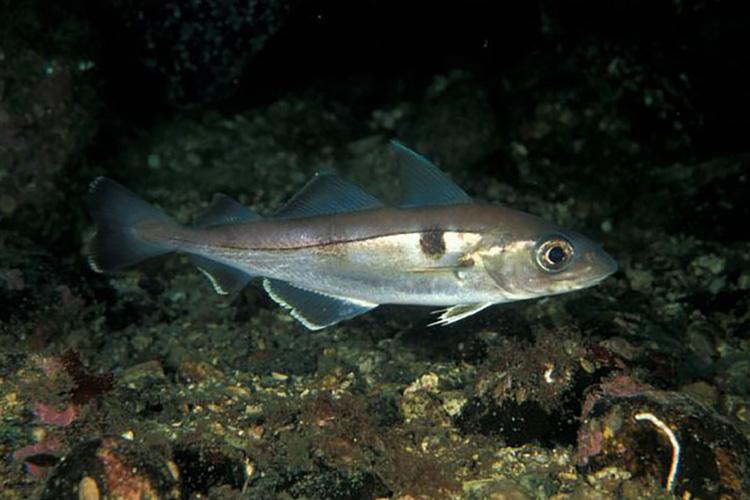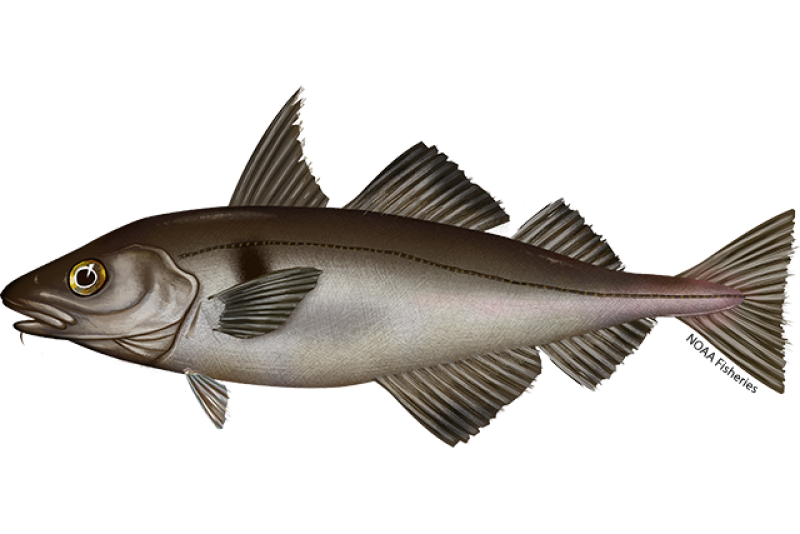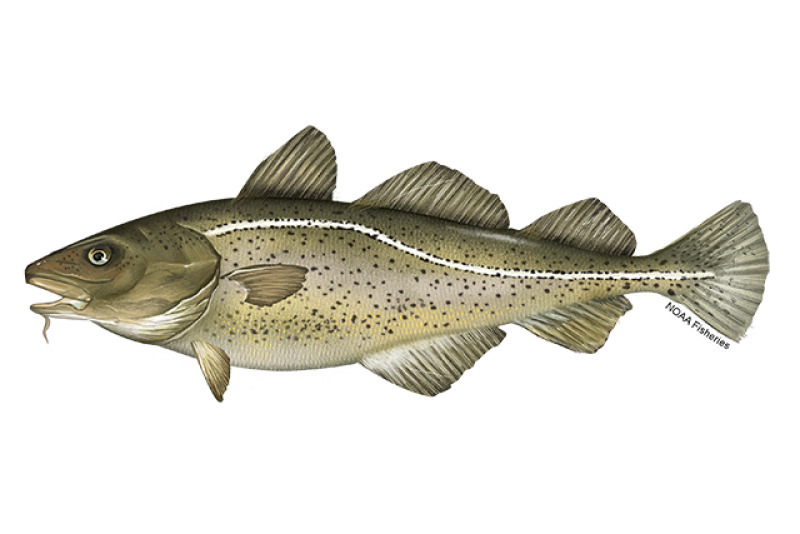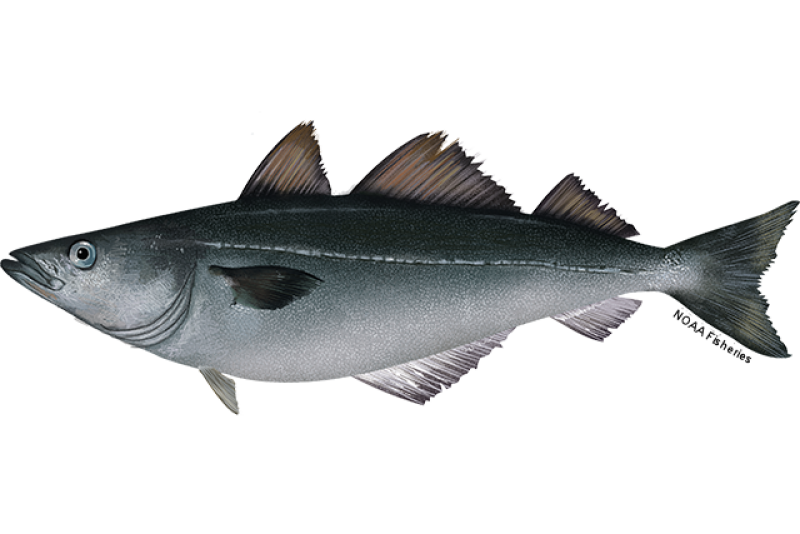 Haddock fish in the water. Credit: NOAA Fisheries
Haddock fish in the water. Credit: NOAA Fisheries
Haddock fish in the water. Credit: NOAA Fisheries
About the Species
 Haddock fish in the water. Credit: NOAA Fisheries
Haddock fish in the water. Credit: NOAA Fisheries
Haddock fish in the water. Credit: NOAA Fisheries
Haddock are found on both sides of the North Atlantic. In the western North Atlantic, they’re found from Newfoundland to Cape May, New Jersey, and are most abundant on Georges Bank and in the Gulf of Maine.

Population
The Gulf of Maine and Georges Bank stocks are not overfished.

Fishing Rate
Not subject to overfishing.

Habitat Impact
Area closures and gear restrictions protect habitat that are affected by some kinds of trawl gear.

Bycatch
Regulations are in place to minimize bycatch.
Population Status
- There are two stocks of haddock: Georges Bank and Gulf of Maine stocks. According to the most recent stock assessments:
- The Georges Bank stock is not overfished and is not subject to overfishing (2024 stock assessment). Summary stock assessment information can be found on Stock SMART.
- The Gulf of Maine stock is not overfished and is not subject to overfishing (2024 stock assessment). Summary stock assessment information can be found on Stock SMART.
Appearance
- Haddock are a member of the cod family, but they are smaller than Atlantic cod.
- They can be distinguished by a black “thumbprint” found on each side of their body.
- Their skin is also less mottled than cod.
Biology
- Haddock are a fast-growing species that typically range between 1 and 3 feet long at maturity.
- They can live for 10 or more years, although NOAA Fisheries scientists typically catch haddock that are between 3 and 7 years old.
- They generally weigh between 2 and 7 pounds.
- Haddock begin to reproduce between the ages of 1 and 4 years old and at 10.5 to 11.7 inches long.
- They spawn between January and June on eastern Georges Bank, to the east of Nantucket Shoals and along the Maine coast over rock, gravel, sand, or mud bottoms.
- Haddock are very productive. Every year, an average-sized female produces around 850,000 eggs, and larger females can produce up to 3 million eggs.
- Females release their eggs in batches near the ocean floor, where a courting male fertilizes them.
- Once fertilized, eggs rise to the surface where they drift with ocean currents.
- Newly hatched haddock remain near the surface for several months before they settle to the bottom.
- Haddock feed on a variety of bottom-dwelling animals, including mollusks, worms, crustaceans, sea stars, sea urchins, sand dollars, brittle stars, and occasional fish eggs.
- Adults sometimes eat small fish, especially herring.
- Spiny dogfish, skates, and many groundfish species (cod, pollock, cusk, hake, monkfish, halibut, and sea raven) prey on juvenile haddock. Gray seals also prey on haddock.
Where They Live
Range
- Haddock are found on both sides of the North Atlantic. In the western North Atlantic, they’re found from Newfoundland to Cape May, New Jersey, and are most abundant on Georges Bank and in the Gulf of Maine.
Habitat
- Haddock are groundfish—they live near the bottom and prefer habitats of gravel, pebbles, clay, and smooth hard sand.
- These bottom types are more common on Georges Bank. Haddock are more abundant there than in the Gulf of Maine.
- Haddock are most common in waters approximately 130 to 500 feet deep and prefer temperatures below 45° F.
- Juveniles are found in shallower water on bank and shoal areas, while larger adults are more common in deeper water.
- Adults travel to shallower waters in the spring to spawn.
Fishery Management
- There are two stocks of haddock in U.S. waters, the Gulf of Maine and Georges Bank stocks.
- NOAA Fisheries and the New England Fishery Management Council manage Gulf of Maine haddock; NOAA Fisheries and the New England Fishery Management Council collaborate with Canada to jointly manage Georges Bank haddock, because the stock spans both waters.
- Haddock, along with other groundfish in New England waters, are managed under the Northeast Multispecies Fishery Management Plan, which includes:
- Permitting requirements for commercial vessels.
- Separate management measures for recreational vessels.
- Time/Area Closures to protect spawning fish and habitat.
- Minimum fish sizes to prevent harvest of juvenile fish.
- Annual catch limits, based on best available science.
- An optional sector (catch share) program can be used for cod and other groundfish species. The sector program allows fishermen to form harvesting cooperatives and work together to decide when, where, and how they harvest fish.
Harvest
- Commercial fishery:
- In 2023, commercial landings of haddock totaled 10.5 million pounds and were valued at approximately $13 million, according to the NOAA Fisheries commercial fishing landings database.
- Gear types, habitat impacts, and bycatch:
- Haddock are commonly harvested using trawl nets, gillnets, bottom longlines, and rod and reel.
- Gillnets, longlines, and rod and reel used to harvest haddock have little to no impact on habitat.
- Areas closures and gear restrictions reduce habitat impacts from trawl nets.
- Fishermen follow management measures to designed to reduce interactions with marine mammals, including gear modifications, seasonal closures, and use of marine mammal deterrents.
- Recreational fishery:
- Haddock are highly prized by recreational fishermen. Recreational vessels make up a significant proportion of the harvest in the Gulf of Maine.
- Haddock are commonly harvested by anglers fishing offshore waters with bait. Fishing occurs year-round.
- In 2023, recreational anglers landed 800,000 pounds, according to the NOAA Fisheries recreational fishing landings database.
- Regulations include seasons, minimum fish sizes and possession limits.
Scientific Classification
- Haddock are found on both sides of the North Atlantic. In the western North Atlantic, they’re found from Newfoundland to Cape May, New Jersey, and are most abundant on Georges Bank and in the Gulf of Maine.
- Haddock are groundfish—they live near the bottom and prefer habitats of gravel, pebbles, clay, and smooth hard sand.
- These bottom types are more common on Georges Bank. Haddock are more abundant there than in the Gulf of Maine.
- Haddock are most common in waters approximately 130 to 500 feet deep and prefer temperatures below 45° F.
- Juveniles are found in shallower water on bank and shoal areas, while larger adults are more common in deeper water.
- Adults travel to shallower waters in the spring to spawn.
Fishery Management
- There are two stocks of haddock in U.S. waters, the Gulf of Maine and Georges Bank stocks.
- NOAA Fisheries and the New England Fishery Management Council manage Gulf of Maine haddock; NOAA Fisheries and the New England Fishery Management Council collaborate with Canada to jointly manage Georges Bank haddock, because the stock spans both waters.
- Haddock, along with other groundfish in New England waters, are managed under the Northeast Multispecies Fishery Management Plan, which includes:
- Permitting requirements for commercial vessels.
- Separate management measures for recreational vessels.
- Time/Area Closures to protect spawning fish and habitat.
- Minimum fish sizes to prevent harvest of juvenile fish.
- Annual catch limits, based on best available science.
- An optional sector (catch share) program can be used for cod and other groundfish species. The sector program allows fishermen to form harvesting cooperatives and work together to decide when, where, and how they harvest fish.
Harvest
- Commercial fishery:
- In 2023, commercial landings of haddock totaled 10.5 million pounds and were valued at approximately $13 million, according to the NOAA Fisheries commercial fishing landings database.
- Gear types, habitat impacts, and bycatch:
- Haddock are commonly harvested using trawl nets, gillnets, bottom longlines, and rod and reel.
- Gillnets, longlines, and rod and reel used to harvest haddock have little to no impact on habitat.
- Areas closures and gear restrictions reduce habitat impacts from trawl nets.
- Fishermen follow management measures to designed to reduce interactions with marine mammals, including gear modifications, seasonal closures, and use of marine mammal deterrents.
- Recreational fishery:
- Haddock are highly prized by recreational fishermen. Recreational vessels make up a significant proportion of the harvest in the Gulf of Maine.
- Haddock are commonly harvested by anglers fishing offshore waters with bait. Fishing occurs year-round.
- In 2023, recreational anglers landed 800,000 pounds, according to the NOAA Fisheries recreational fishing landings database.
- Regulations include seasons, minimum fish sizes and possession limits.
Scientific Classification
| Kingdom | Animalia | Phylum | Chordata | Class | Actinopterygii | Order | Gadiformes | Family | Gadidae | Genus | Melanogrammus | Species | aeglefinus |
|---|
Last updated by NOAA Fisheries on 03/25/2025
Featured News
NOAA Fisheries Partners with Northeast Groundfish Industry to Update Key Data for Stock Assessments
 Projected cooler temperatures in the Gulf of Maine could influence the productivity of species like American lobster, which prefer colder waters. Credit: Matthew Lawrence/NOAA
Projected cooler temperatures in the Gulf of Maine could influence the productivity of species like American lobster, which prefer colder waters. Credit: Matthew Lawrence/NOAA
New Seasonal Forecast Predicts Cooler Waters in Northeast
 The NOAA research vessel Gloria Michelle conducts groundfish surveys in New England, an important mission to support science-based fisheries management. Photo credit: NOAA Fisheries
The NOAA research vessel Gloria Michelle conducts groundfish surveys in New England, an important mission to support science-based fisheries management. Photo credit: NOAA Fisheries
As Fishing Season Opens, NOAA Implements Emergency Action to Ensure Uninterrupted Northeast Fisheries
 Juvenile coho salmon. Credit: iStock
Juvenile coho salmon. Credit: iStock
NOAA Fisheries Releases 2023 Status of Stocks
Seafood Facts

Is Haddock Sustainable?
U.S. wild-caught haddock is a smart seafood choice because it is sustainably managed and responsibly harvested under U.S. regulations.
Availability
Year-round.
Source
U.S. wild-caught mostly from Maine to New Jersey.
Taste
Slightly sweet.
Texture
Firm yet tender. Its delicate flake is finer than that of cod.
Color
Raw haddock is white and becomes even whiter when cooked.
Health Benefits
Haddock is a great source of low-fat protein, magnesium, and selenium.
Nutrition Facts
Servings: 1; Serving Weight: 100 g (raw); Calories: 87; Protein: 18.91 g; Total Fat: 0.72 g; Total Saturated Fatty Acids: 0.13 g; Carbohydrate: 0 g; Total Sugars: 0 g; Total Dietary Fiber: 0 g; Cholesterol: 57 mg; Selenium: 30.2 mcg; Sodium: 68 mgMore Information
Haddock Recipes
Looking for some ways to add white fish like haddock into your diet? If you need some cooking inspiration, browse these recipes for fish sticks, baked haddock, and more!

Last updated by NOAA Fisheries on 03/25/2025
Seafood News
 Photo credits: Tampa Bay Watch (top left); South Carolina Aquarium (top right); North Carolina Oyster Trail (bottom left); Tagal Oceanic/Lisa Tagal (bottom right)
Photo credits: Tampa Bay Watch (top left); South Carolina Aquarium (top right); North Carolina Oyster Trail (bottom left); Tagal Oceanic/Lisa Tagal (bottom right)
A Little Goes a Long Way: How Small Programs Are Educating Communities About Farmed Seafood
 Credit: NOAA Fisheries and Partners
Credit: NOAA Fisheries and Partners
Part 2: Seafood Tips from the People Bringing You America's Seafood
 Commercial fishing boats lined up in Sitka, Alaska. Credit: Shutterstock.
Commercial fishing boats lined up in Sitka, Alaska. Credit: Shutterstock.
NOAA Fisheries Seeks Recommendations for Restoring American Seafood Competitiveness

Celebrate Seafood This Holiday Season
Management Overview
Haddock is managed under the Northeast Multispecies (Groundfish) Fishery Management Plan along with 12 other species of groundfish. Collectively, these 13 species are referred to as the Northeast multispecies complex.
Learn more about the Northeast multispecies complex and its management
Last updated by NOAA Fisheries on 03/25/2025
Documents
Age Determination Methods for Northwest Atlantic Species
This manual documents age determination techniques used by staff at the Woods Hole Laboratory to…
Data & Maps
Accuracy and Precision of Fish Ages - Northeast
It is important to ensure consistency in fish ages used in fish population assessments. The Fishery…
United States-Canada Northeast Groundfish Management Areas
This dataset depicts the boundaries of the US-Canada Management Areas.
Northeast Groundfish Trimester Total Allowable Catch Areas
This dataset depicts the boundaries of the Trimester TAC Areas.
Summer Flounder Small-Mesh Exemption Area
This dataset depicts the boundaries of the Summer Flounder Small-Mesh Exemption Area.
Research
Transboundary Resources Assessment Committee Documents
Peer-reviewed stock assessments performed by Transboundary Resources Assessment Committee, a…
Passive Acoustics Research Group News & Media
Our Passive Acoustics Research Group frequently makes the news. This page links to articles and other media featuring our staff and their research.
Last updated by NOAA Fisheries on 03/25/2025



